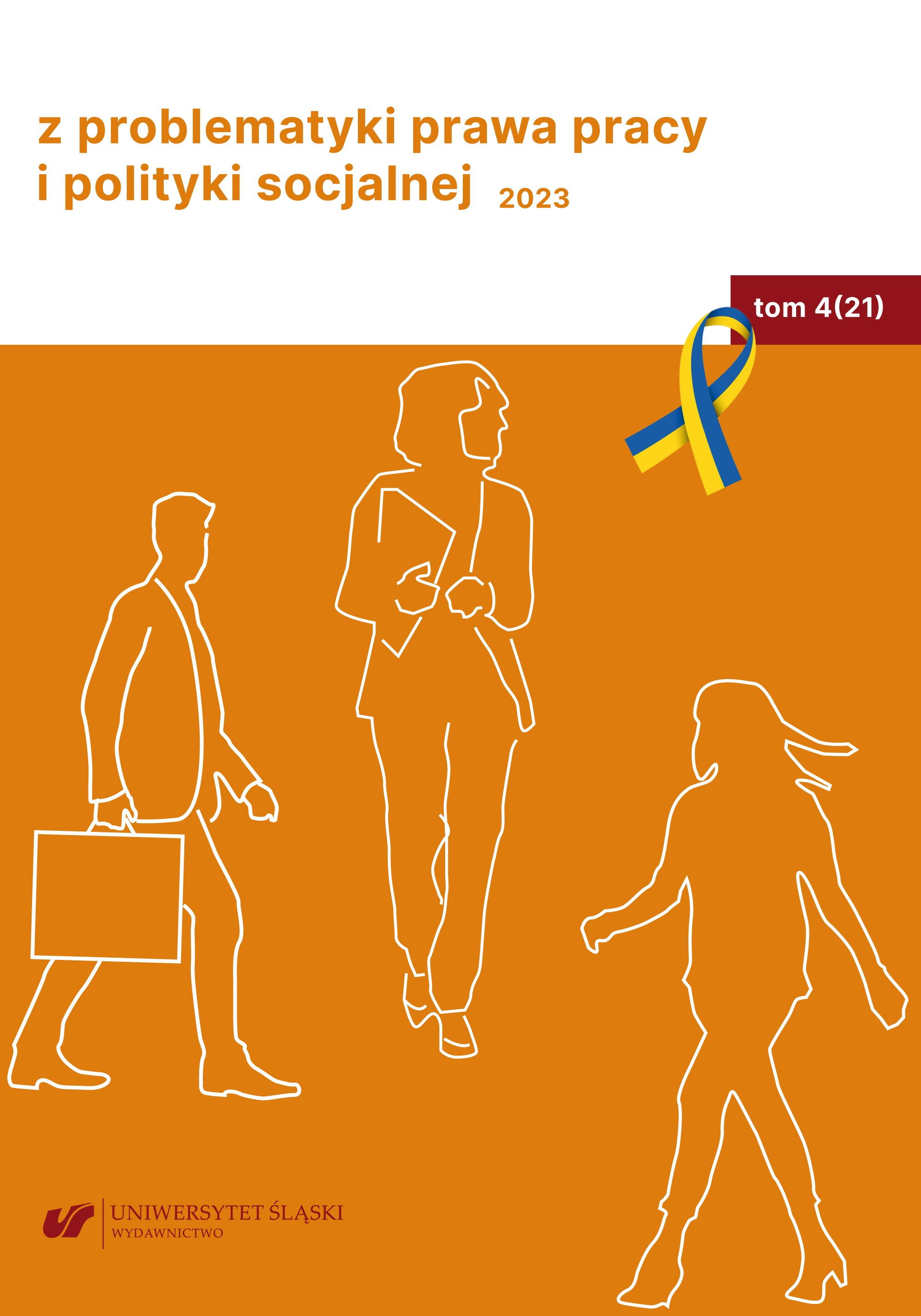Literature
Google Scholar
Bakalarz, T.: Zatrudnienie za pośrednictwem platformy internetowej jako przejaw „uberyzacji” Pracy. “Acta Universitatis Wratislaviensis. Przegląd Prawa i Administracji” 2019, vol. 117.
Google Scholar
Bernaciak, M.: Market Expansion and Social Dumping in Europe. London 2015.
Google Scholar
Donovan, S., Bradley, D., Shimabukuro, J.: What Does the Gig Economy Mean for Workers? Washington 2016. ETUC: Action programme 2019–2023. Vienna 2019.
Google Scholar
Eurofound: Employment and Working Conditions of Selected Types of Platform Work. Publications Office of the European Union, Luxembourg 2018.
Google Scholar
Eurofound: Platform Work: Types and Implications for Work and Employment – Literature Review. Publications Office of the European Union, Luxembourg 2018.
Google Scholar
European Commission: Improving Working Conditions in Platform Work. Brussels 2021.
Google Scholar
Europejska Agencja Bezpieczeństwa i Zdrowia w Pracy: Ochrona Pracowników w gospodarce platform online: przegląd zmian regulacyjnych w zakresie polityki w UE. Streszczenie. Luksemburg 2017.
Google Scholar
Gerber, Ch., Krzywdzinski, M.: Brave New Digital Work? New Forms of Performance Control in Crowdwork. In: S. Vallas, A. Kovalainen (eds.): Work and Labor in the Digital Age. Emerald Publishing 2019.
Google Scholar
ILO: World Employment and Social Outlook – The Role of Digital Labour Platforms in Transforming the World of Work. Geneva 2021.
Google Scholar
Instytut Analiz Rynku Pracy: Czwarta rewolucja przemysłowa i jej wpływ na rynek pracy – raport tematyczny. Warszawa 2020.
Google Scholar
Instytut Analiz Rynku Pracy: Alternatywne formy pracy. Warszawa 2020.
Google Scholar
Lehndonvirta, V.: Algorithms that divide and unite, delocalization, identity, and collective action in ‘microwork’. In: J. Flecker (ed.): Space, Place and Global Digital Work. London 2016.
Google Scholar
Makowska, M.: Ochrona pracowników platform internetowych w UE. “Biuletyn PISM” 2021, no. 221 (2419).
Google Scholar
OPZZ: Program Ogólnopolskiego Porozumienia Związków Zawodowych na lata 2018–2022.Warszawa 2018.
Google Scholar
OPZZ: Najważniejsze postulaty OPZZ do programów wyborczych na euro wybory. Warszawa 2019.
Google Scholar
Pańków, M., Owczarek, D., Koziarek, M.: Nowe formy pracy w Polsce (ed. D. Owczarek). Fundacja ISP, Warszawa 2018.
Google Scholar
Proposal for a directive of the European Parliament and of the Council on improving working conditions in platform work from 9 December 2021, 2021/0414 (COD).
Google Scholar
Raczkowski, M.: Bezpieczne i higieniczne warunki pracy w zatrudnieniu cywilno-prawnym. „PiZS” 2019, no. 1/2019.
Google Scholar
Rogalewski, A.: Cyfryzacja i praca platformowa – informator dla pracowników. Warszawa 2020.
Google Scholar
Rostek, R.: Cyfryzacja w organizacji: od zarządzania wiedzą do platformowego nadzoru. „Nowy Obywatel” 2021, no. 35 (86).
Google Scholar
Think-tank Instrat, Fundacja Inicjatyw Strategicznych: Polska Karta Suwerenności Cyfrowej. Warszawa 2020.
Google Scholar
World Economic Forum: The Future Jobs Report 2020 – October 2020. Geneva 2020.
Google Scholar
Zuboff, S.: The Age of Surveillance Capitalism: the Fight for a Human Future at the New Frontier of Power. New York 2019.
Google Scholar
Internet sources
Google Scholar
Spidersweb.pl - https://spidersweb.pl/plus/2021/06/praca-platformy-aplikacje-gig-economyuber-glovo-fixly-emerytury (access 20.04.2022).
Google Scholar
Spidersweb.pl - https://spidersweb.pl/plus/2021/05/kurierzy-glovo-strajk-protest-aplikacjablack-mirror (access 20.04.2022).
Google Scholar
Solidarnosc.org.pl – https://www.solidarnosc.org.pl/aktualnosci/wiadomosci/zagranica/item/20743-pracownicy-platform-cyfrowych-musza-miec-takie-same-prawa-jak-tradycyjni-pracownicy (access 20.04.2022).
Google Scholar
Europarl.europa.eu - https://www.europarl.europa.eu/doceo/document/TA-9-20210385_EN.html (access 28.09.2022)
Google Scholar


 https://doi.org/10.31261/zpppips.2023.21.07
https://doi.org/10.31261/zpppips.2023.21.07

 10.31261/zpppips
10.31261/zpppips